
Goizueta is a town and municipality located in the province and autonomous community of Navarre, northern Spain.

Goizueta is a town and municipality located in the province and autonomous community of Navarre, northern Spain.
The Spanish conquest of Iberian Navarre started in 1512 with a Guipuzkoan militia capturing it on 10 July 1512.
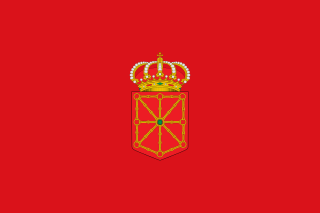
Navarre, officially the Chartered Community of Navarre, is an autonomous community and province in northern Spain, bordering the Basque Autonomous Community, La Rioja, and Aragon in Spain and Nouvelle-Aquitaine in France. The capital city is Pamplona. The best-known event in Navarre is the San Fermín festival in July held in Pamplona. It corresponds to the southern portion of the medieval Kingdom of Navarre.

Henry II, nicknamed Sangüesino because he was born at Sangüesa, was the King of Navarre from 1517, although his kingdom had been reduced to a small territory north of the Pyrenees by the Spanish conquest of 1512. Henry succeeded his mother, Queen Catherine, upon her death. His father was her husband and co-ruler, King John III, who died in 1516.

Tudela is a municipality in Spain, the second largest city of the autonomous community of Navarre and twice a former Latin bishopric. Its population is around 35,000. The city is sited in the Ebro valley. Fast trains running on two-track electrified railways serve the city and two freeways join close to it. Tudela is the capital of the agricultural region of Ribera Navarra, and also the seat of the courts of its judicial district.

Lower Navarre is a traditional region of the present-day French département of Pyrénées-Atlantiques. It corresponds to the northernmost merindad of the Kingdom of Navarre during the Middle Ages. After the Spanish conquest of Iberian Navarre (1512–24), this merindad was restored to the rule of the native king, Henry II. Its capitals were Saint-Jean-Pied-de-Port and Saint-Palais. In the extreme north there was the little sovereign Principality of Bidache, with an area of 1,284 km2 (496 sq mi) and a decreasing population of 44,450, 25,356.

Roncesvalles is a small village and municipality in Navarre, northern Spain. It is situated on the small river Urrobi at an altitude of some 900 metres (3,000 ft) in the Pyrenees, about 4 kilometres (2.5 mi) from the French frontier as the crow flies, or 21 kilometres (13 mi) by road.

John III was jure uxoris King of Navarre from 1484 until his death, as husband and co-ruler with Queen Catherine.
Francis Phoebus was King of Navarre (1479–1483), Viscount of Bearn, and Count of Foix (1472). He was the son of Gaston, Prince of Viana, and grandson of Queen Eleanor, whom he succeeded. She recommended him to ally with France.
Catherine, Queen of Navarre, reigned from 1483 until 1517. She was also Duchess of Gandia, Montblanc, and Peñafiel, Countess of Foix, Bigorre, and Ribagorza, and Viscountess of Béarn.

Ezkurra is a town and municipality located in the province and autonomous community of Navarre, northern Spain. The town's name is from the Basque language of the locals.

Urrotz is a town and municipality located in the province of Navarre, in the autonomous community of Navarre, northern Spain.
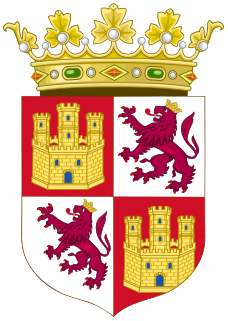
Eleanor of Navarre, was the regent of Navarre from 1455 to 1479, then briefly the queen regnant of Navarre in 1479. She was crowned on 28 January 1479 in Tudela.

Saint-Étienne-de-Baïgorry is a commune in the Pyrénées-Atlantiques department in south-western France, located at the same time in the former province of Lower Navarre. It borders the municipality of Baztan to the west.
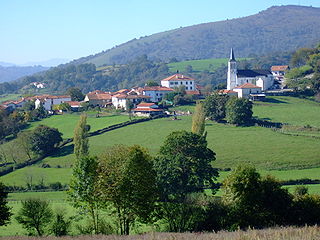
Ostabat-Asme, Hostavalem in the Middle Ages, is a commune in the Pyrénées-Atlantiques department, formerly located in the region described for many centuries as Lower Navarre, in south-western France. It was the meeting point of 4 European ways to Santiago de Compostela, 3 of them joining together there, namely Paris - Tours - Poitiers - Dax, from Center - Europe linking to Limoges, from Genoa and Lyon through Moissac, the fourth one the Toulouse way, linking Central Italy with the Languedoc region, the Toulouse region and linking though the Béarn region, via Lescar-Oloron to Somport, Spain, and the Spanish Pyrénées.

The Viscounty, later Principality, of Béarn was a medieval lordship in the far south of France, part of the Duchy of Gascony from the late ninth century. In 1347, the viscount refused to acknowledge the suzerainty of the French king and declared Béarn an independent principality. It later entered a personal union with the Kingdom of Navarre in 1479 and with France in 1589. In 1620, the prince formally incorporated Béarn as a province of France.

Carbon Power Plant, also known as Castle Gate Power Plant was a small, 190-MWe coal-fired power station in Utah, USA operated by PacifiCorp. Its units 1 and 2, rated at 75 and 113.6 MWe, were launched into service in 1954 and 1957. The plant is located at 39°43′38″N110°51′51″W, about 3 km (2 mi) north of Helper, Utah, on the east bank of Price River.

The Spanish conquest of the Iberian part of Navarre was initiated by Ferdinand II of Aragon and completed by his grandson and successor Charles V in a series of military campaigns lasting from 1512 to 1524. Ferdinand was both the king of Aragon and regent of Castile in 1512. When Pope Julius II declared a Holy League against France in late 1511, Navarre attempted to remain neutral. Ferdinand used this as an excuse to attack Navarre, conquering it while its potential protector, France, was beset by England, Venice, and Ferdinand's own Italian armies.
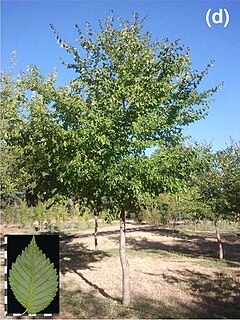
The elm cultivar Ulmus 'Toledo' was raised from seed collected in 1999 from a tree believed to be Ulmus minor growing in the eponymous city, by researchers at the Escuela Técnica Superior de Ingenieros de Montes, Universidad Politėcnica de Madrid. However, retrospective DNA analysis revealed that the clone also had Ulmus pumila DNA, the species introduced to Spain at the end of the 16th century.
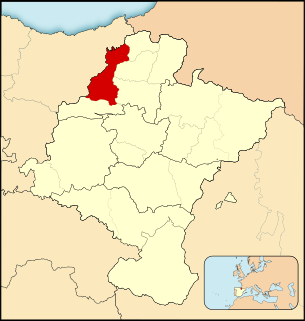
Norte de Aralar is a comarca in Navarre, Spain.
Subiza is a Spanish town located in the province and autonomous community of Navarre, belonging to the municipality of Galar, in northern Spain. Its population in 2014 was of 191 inhabitants (INE).
The Estates of Navarre(French: États de Navarre, États généraux de Navarre, Cortes de Navarre) were created in 1317 under Philip II. The Estates of Lower Navarre(French: États de Basse-Navarre, Cortes de la Basse-Navarre) were first called into session on 28 August 1523 by Henry II after the definitive loss of Upper Navarre,
Bustillo Kastrexana, Joxerra (2012). Guía de la conquista de Navarra en 12 escenarios. Donostia: Txertoa Argitaletxea. ISBN 978-84-71484819
Coordinates: 43°10′16″N1°51′51″W / 43.17111°N 1.86417°W